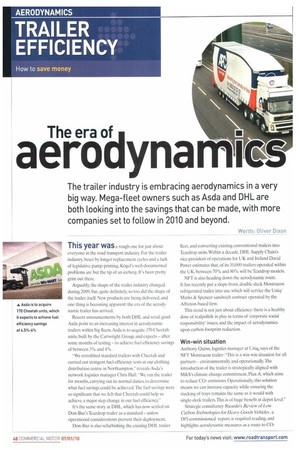aefoilynamp
Page 48

Page 49

If you've noticed an error in this article please click here to report it so we can fix it.
The trailer industry is embracing aerodynamics in a very big way. Mega-fleet owners such as Asda and DHL are both looking into the savings that can be made, with more companies set to follow in 2010 and beyond.
Words: Otiver Dixon
This year was. rough one for just about everyone in the road transport industry. For the trailer industry, beset by longer replacement cycles and a lack of legislative pump-priming. Ktigel's well-documented problems are but the tip of an iceberg. It's been pretty grim out there.
Arguably, the shape of the trailer industry changed during 2009, but, quite definitely, so too did the shape of the trailer itself. New products are being delivered, and one thing is becoming apparent: the era of the aerodynamic trailer has arrived.
Recent announcements by both DHL and retail giant Asda point to an increasing interest in aerodynamic trailers within big fleets. Asda is to acquire 170 Cheetah units, built by the Cartwright Group, and expects after some months of testing to achieve fuel efficiency savings of between 3% and 4%.
-We retrofitted standard trailers with Cheetah and carried out stringent fuel-efficiency tests at our clothing distribution centre in Northampton," reveals Asda's network logistics manager Chris Hall. "We ran the trailer for months, carrying out its normal duties, to determine what fuel savings could be achieved, The fuel savings were so significant that we felt that Cheetah could help us achieve a major step change in our fuel efficiency"
It's the same story at DHL, which has now settled on Don-Bur's Teardrop trailer as a standard unless operational considerations prevent their deployment.
Don-Bur is also refurbishing the existing DHL trailer fleet, and converting existing conventional trailers into Teardrop units. Within a decade, DHL Supply Chain's vice-president of operations for UK and Ireland David Potter estimates that, of its 10,000 trailers operated within the UK, between 70% and 80% will be Teardrop models.
NET is also heading down the aerodynamic route. It has recently put a slope-front, double-deck Montracon refrigerated trailer into use, which will service the Uniq/ Marks & Spencer sandwich contract operated by the Alfreton-based firm.
This trend is not just about efficiency: there is a healthy dose of realpolitik in play in terms of 'corporate social responsibility' issues, and the impact of aerodynamics upon carbon footprint reduction.
Win-win situation Anthony Quinn. logistics manager at iJniq, says of the NFT Montracon trailer: "This is a win-win situation for all partners environmentally and operationally. The introduction of the trailer is strategically aligned with M&S's climate change commitment, Plan A, which aims to reduce CO2 emissions. Operationally, this solution means we can increase capacity while ensuring the stacking of trays remains the same as it would with single-deck trailers.This is of huge benefit at depot level."
Strategic consultancy Ricardo's Review of Low Carbon Technologies for Heavy Goods Vehicles, a Df f-commissioned report, is required reading, and highlights aerodynamic measures as a route to CO-2 reduction. But there are caveats.
"Aerodynamics are more applicable to the long-haul sector operating at constant higher speeds,explains Ricardo's Hannah Baker, "The impact within the medium-duty and distribution segments is less, and fitting cab deflectors may have an overall positive effect."
However, on balance, there does seem to be a significant shift towards the adoption of aerodynamic trailer shapes. "The market is certainly moving in the direction of aerodynamic trailers," says Don-Bur group marketing manager Richard Owens. "The third-party logistics (3PLs) providers will tend to purchase on efficiency — namely on the cost per kg goods moved per mile. On the other hand, the more general haulier tends to buy on capital cost. If you have a trailer that reduces drag by 30%. you will he likely to save 10% in fuel costs."
Owens suggests it would take around a year to repay the premium attached to specifying a Teardrop trailer over a conventionally shaped unit. "There should be a relatively fast payback, but this will be most apparent within the HD long-haul segment," says Nick Powell of Ricardo.
"This type of trailer will become standard over time.: says Lawrence David's Chris Curzon. "People are sceptical at the moment, and it will take time for the benefits to filter through. Our product offers the positive impact of an aerodynamic shape, but with no loss of capacity, and we have a number of aerodynamic trailers going into a major rental fleet early in 2010."
Hands-on approach Capital expenditure has been thin on the ground over the past few months, and introducing operators to aerodynamic trailers via the hands-on approach of spot hire would seem to be a shrewd move.The rental industry has seen a shift towards lengthening transient rentals as a lack of appetite for commitment renders more traditional contract hire unappealing. As such, putting aerodynamics into a shop window such as spot rental could, along with the trickle-down impact from the large fleets, he a very positive driver in terms of their market adoption rates Most predictions put truck demand in the UK during 2010 as being on a par with that witnessed in 2009, at around 28,000 units. It would seem reasonable to assume that trailer demand will be similarly muted. However, there does seem to be clear evidence suggesting that demand for aerodynamic trailers is growing, and may in fact be causing the replacement cycle to shift. This has to be regarded as highly positive in a sector that has seen some spectacular negatives over the past few months. •




























































































































